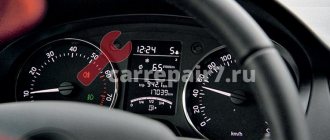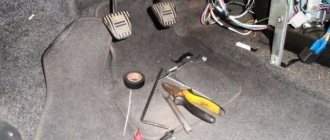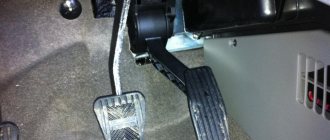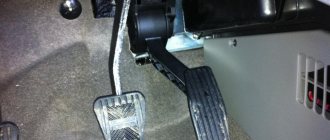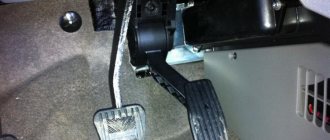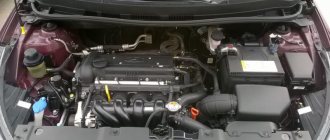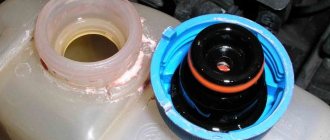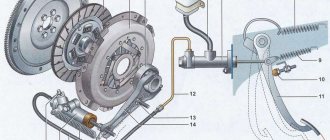The trend of recent years in the automotive industry is the gradual removal of the driver from the process of driving. Designers and marketers have not yet reached the point of losing the connection between arms and legs with turning wheels and braking, but everything is moving towards this. Not a single modern car is supplied to the market without an electronic throttle and an electronic accelerator.
Electronics are reliable things, but sometimes they fail.
The design and principle of operation of the electronic gas pedal
To understand how it works and functions, you need to roughly understand the general circuit of the mechanical analogue. The functions of these systems are similar, but the simplest unit can only be considered a traditional drive.
The gas pedal is a control element for the throttle and its damper. The function of the throttle is to regulate the amount of air. The more air, the higher the engine speed the crankshaft will rotate. The pedal is connected to the throttle drive via a cable drive or levers. All this significantly reduces the effort required to press the gas.
The operating principle of the electronic unit is more complex, but this makes the process of controlling speed easier. The electronic accelerator is used only on engines with an injection power system. Its device is completely electronic. It is based on electronic modules that convert electrical signals.
Benefits of Electronic Throttle Control
Electronic throttle control systems can seem a little pointless. After all, if a mechanical system works, why complicate it?
Reliability
Mechanical throttle systems, because they have many moving parts, are subject to significant wear and tear. Over the life of a vehicle, various components can wear out.
The electronic throttle control system has relatively few moving parts—it sends signals using an electrical pulse rather than moving parts. This reduces wear and maintenance.
Safety
E-gas adds a number of safety advantages over mechanical systems. With mechanical control, the degree to which the throttle valve opens or closes depends only on the driver's actions.
Thanks to the ED, the control unit not only reads the data coming from the driver's foot pressing the gas pedal, but also checks the signals coming from the slipping wheels, steering system and brakes, helping to correct the driver's error and keep the car under control.
In other words, E-GAS can take into account multiple factors that affect a car's speed and handling, not just your foot on the pedal.
Electronic Throttle Control integrates advanced driver safety features such as adaptive cruise control, brake lock systems and electronic stability control, making the vehicle safer in adverse weather conditions (rain, snow, ice, etc.).
Plus, the electronic throttle responds faster than the driver in situations where the tires don't have enough grip, keeping you safe and keeping your car on the road.
Environmentally friendly and economical
Controlling the throttle valve via the ECU reduces harmful emissions and improves vehicle efficiency. This is achieved due to the fact that the control unit takes into account not only the pedal press, but also data from many sensors: speed, oxygen, temperature, etc.
Symptoms of a problem
Among the main signs of problems are:
- Absence of any reaction to the accelerator after starting the vehicle’s internal combustion engine;
- Dips, loss of throttle response while driving;
- Floating idle speed;
- Sharp jumps in speed when you gently press the accelerator;
- Idle speed too high.
The device contains movable electrical contacts, as well as conductive tracks - these elements are subject to wear during operation. In the operation of the engine, you can observe dips when picking up speed, unstable idling.
Related article: 5 of the best car speakers for high-quality sound
If there is a malfunction in the unit, the driver can see this by a warning light on the dashboard. In such a situation, the ECU will switch the engine to standby mode.
In this mode, you can observe a slow increase in speed, even if you press the accelerator sharply. In addition, the vehicle's fuel consumption may increase significantly.
If two sensors in a unit fail at once, the ECU will switch the operation of the internal combustion engine to emergency mode - the driver will not be able to influence the operation of the engine, the speed under any conditions will be slightly higher than the idle speed.
How Electronic Throttle Control Works
Compared to the cable throttle, two parts were added to the E-gas:
- damper rotation motor;
- second (control) throttle position sensor (TPS No. 2).
TPS No. 2 operates in “antiphase” with the first one - its signal increases or decreases by the same amount as the signal from the main TPS No. 1.
Electronic throttle valves may differ in the percentage of opening in the de-energized state and the type of TPS.
- Fully closed in a de-energized state - one spring for full closure.
- Slightly opened by 5-7% - two springs, the balance point is in the slightly opened zone. This allows the engine to operate at low speeds in the event of a complete failure of the throttle electronics. Such dampers are more modern than completely closed ones, with which, if they break, the engine will not work at all.
- With contact TPS - inside slider variable resistors.
- With contactless TPS - there are no rubbing moving contacts inside, the output signal is generated electronically.
Working principle of E-gas:
- The driver presses the accelerator pedal. The degree of pressure is converted through sensors into an electrical signal and transmitted via wires to the computer.
- The ECU controls the closing/opening of the damper using PWM power through a motor. Both the duty cycle of the PWM and the polarity change.
- Based on signals from the TPS, the position of the damper is analyzed and the control signal is changed if necessary.
- Errors in the operation of the throttle valve are monitored.
Adjustment
The adjustment process may vary on different car models, since different manufacturers use mechanisms of different designs. But the same principle can be applied for configuration. As for a specific model, it is better to find information on it in advance.
To begin the adjustment, the first step is to remove the pedal from the holding bracket. Next, loosen the screws securing the cover. One screw holds the cover in a certain position - it must be completely unscrewed. The cover is turned to the side clockwise until the end, then the screws are tightened again.
This is interesting: How to make a foam generator for a car wash with your own hands
This adjustment will reduce pedal response time. Some car owners note that after such adjustments, the response speed can even be compared with a mechanical pedal. Adjustment allows you to improve engine performance and improve the start of movement from a standstill.
In cases where a pedal with low sensitivity is needed, it is necessary to rotate the cover in the opposite direction - counterclockwise. The machine begins to respond to presses not so quickly.
Sometimes you can come across harmful adjustment tips - drivers advise placing shims under the lever. This is the wrong approach. Sometimes the pads get caught under the contact pads in the potentiometer, and the machine may lose control as a result.
How to check serviceability
An electronic potentiometric gas pedal (without a built-in digital converter) can be checked using a conventional multimeter in resistance measurement mode. Using the VW GOLF as an example, the check is carried out according to the table given above in this article.
In order not to dismantle the gas pedal, you can control the resistance from the engine control unit, as shown in the figure:
Similarly, for other car models, you need to know the pinout of the engine control unit and the resistance table when moving the potentiometer. You can use the AUTODATA 3.45 program.
In the case of digital electronic pedals, fault monitoring is only possible using computer diagnostics.
If the electronic gas pedal malfunctions, you can replace it completely or replace only the sensor unit.
Very hard pedal
The pedal is tight, the stroke is short when pressed... When braking, the car loses directional stability, trying to go to the side. Most often this happens when the caliper cylinders jam in one of the system circuits. If the car does not skid anywhere, and the trouble is expressed only in a sharply increased force when braking, the vacuum brake booster or the vacuum supply hose may be to blame.
Sometimes increased pedal effort is caused by the use of low-quality brake pads, as well as excessive contamination and oiling of both the pads themselves and the surfaces of the discs or drums. But this happens quite rarely.
It is also possible that the brake pads may completely wear out or break. It happens that an ice or salt crust forms on the surface of the disks. It is also possible that the brake pad linings are of poor quality, as well as severe corrosion of the brake disc (often more on the inside).
conclusions
The main cause of failures are spark plugs, but they are not the only ones that influence the appearance of this effect. Some car enthusiasts may not be able to cope with the occurrence of such malfunctions on their own, and it is necessary to go to a car service center, where they will carry out high-quality diagnostics and also fix the problem. But it is worth considering that you will have to be generous, since neither computer diagnostics nor repairs will cost a penny.
The brakes, of course, were invented by cowards - any reckless driver will tell you that. But when you realize that there is “something wrong” with them, it becomes scary to get behind the wheel: the trip may be your last. We drive thoughts like “it will do” away: the jokes are over. It is important to determine the type of malfunction, at least in advance.
How to adjust the throttle cable of a Lada Priora?
- The adjustment is carried out using a clamping bracket, which we previously removed. This bracket is a tensioner for the casing in which the cable moves.
- Remove the bracket and tighten the throttle cable so that it sags about 1-2 mm near the throttle drive.
- Now you need to install the fixing bracket into place in the casing. Make sure that the cable is tensioned optimally and that the gas pedal is not open at zero position. A cable that is too tight will cause constant high voltage. Squeeze the gas pedal several times and check how everything works.
- Start the engine and make sure the throttle cable is adjusted correctly and the idle speed is normal.
Advantages and disadvantages
Before judging the possible practical application of this system when purchasing a new car, it is necessary to take into account all possible nuances and features of operating a car in such conditions.
The main advantages of this option: adjusting the load on the engine, correcting erroneous actions. Disadvantages - insufficiently fast acceleration and sensitivity to driver actions. With proper running-in and adjustment of the ECU, these disadvantages are somewhat erased; moreover, the use of this device allows you to save fuel and extend the life of the engine.
How will your car change with Jetter?
After installing JETTER
, your car will move to a whole new level of driving. He will become more aggressive, faster, and more maneuverable. The throttle response speed will increase significantly, providing lightning-fast acceleration without dips. It doesn’t matter: you are climbing to the top of a mountain, performing an active overtaking or other maneuver, the jeter will give you a feeling of freedom and comfort throughout the entire journey.
JETTER
will reveal the true character of your car. You will not let go of the feeling that there is a powerful turbocharged engine under the hood. And the exciting start will be appreciated not only by you, but also by those who remain behind you.
WITH JETTER
you will be able to change gears literally in a split second, and this will not affect the behavior of your car in any way. When accelerating, the average delay time in 3rd and 4th gears is practically reduced to zero, as a result, acceleration is smooth, without pause, like in a good automatic transmission. You will fall in love with your car again, feeling its powerful drive and rapid acceleration, getting the most vivid driving experience on any bend.
Repair
If there are any problems with the pedal, then only a complete replacement of the unit will help. But before changing anything, it is worth identifying the cause of the malfunction. To do this, you can use a multimeter test.
You can disconnect the sensors and the block and remove the pedal. Check the resistance - when you press the gas it should change slowly. Jumps in indicators indicate malfunctions.
But sometimes repairs are possible - for example, the wiring is damaged. If a wiring defect is detected, you can use the following diagram.
- Release the axis on which the gear is attached.
- Remove the wiring harness.
- Then the wires are soldered off.
- Release the bracket and pull out the cable.
Next, change the wires and solder them according to the connector under the pedal.
Source
Noise when braking
High-frequency noise, squealing, and whistling can occur both during braking and, sometimes, during normal movement. The reason is the off-design mode of friction of the friction material on the working surface of the brake disc. Extreme wear on the brake pads and severe corrosion of the brake disc (often on the inside, “invisible” side) may be to blame. It happens that the brake pad lining has peeled off from the base. The list of possible causes continues with contamination of the pads, warping of the disc due to local overheating, improper fastening of the pads in the caliper, left pads or discs, etc.
What does the accelerator pedal position sensor do?
In essence, the accelerator pedal is responsible for the amount of fuel entering the engine cylinders. With its help, the shaft rotation speed is also regulated, thanks to which the overall speed of the car and its power are regulated. If we translate the accelerator in the literal sense, then it is an accelerator. Every time the driver presses the pedal, the valves responsible for supplying fuel open more.
It is important to consider what role the accelerator and the control sensor connected to it play in the process of accelerating the car. It should be understood that there is a direct relationship between the engine, or, as it is also called, the heart of the car and the gas pedal.
Using the sensor, the amount of fuel supplied is monitored under various conditions in order to select the optimal amount in a given situation. This allows you not only to monitor, but also to correctly manage this process, as well as the process of engine operation at idle.
In addition, thanks to the accelerator pedal position sensor, a smooth transition of each action is ensured, which significantly reduces jerking of the car and increases the safety of its operation.
In vehicles equipped with an automatic transmission, the role of this sensor expands somewhat. It also provides sharp acceleration of the car when this should be done from a lower gear.
• install special sensors in the extreme position;
• provide an assessment of the degree of change in the sensor resistance;
• provide the possibility of influencing the rigid element of the pedal.
It should be taken into account that the design of sensors is constantly being improved, which allows for increased functionality for monitoring and controlling the engine. The latest achievements in the field of electronics, programming, and modern scientific developments are being actively implemented.
In fact, in addition to the control system, this part also includes feedback from the driver. For example, vibration of the pedal is introduced at certain stages of pressing, or the force for pressing it in a certain position is increased.
